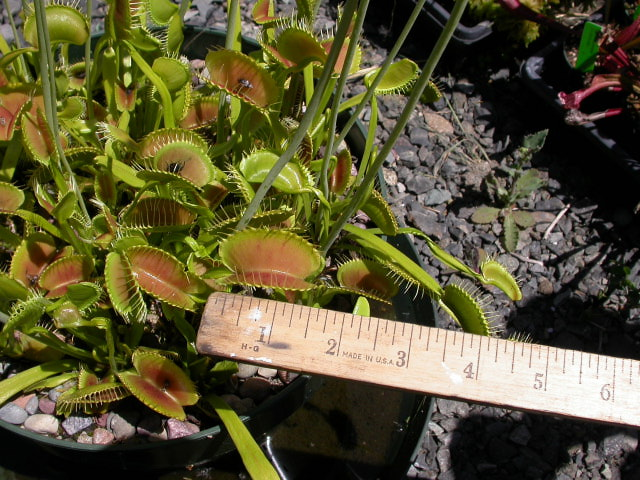QuestionHi,
Jacob at Sarracenia Northwest suggested I summit my below question to you. Thank you
Hi, I posted the below question in flytrapcare.com and a person that replied suggested to touch base with you since I'm in Portland. Hi, We just received a Venus Flytrap yesterday and have some general questions. I did read through the care instructions on the website before posting. My partner ordered it online. I removed the bubble wrap that covered the top, but the rest, plastic pot and top of soil covered with plastic. I assume I remove that. The question is what do I do next? It's in a plastic pot that's 2 1/2" square by 3 1/2" tall. Do I repot? As for light, I live in Portland, OR in an apartment where the windows that get light face north. We do have a front patio/deck that I can place outside and will get (what I think) plenty of light. My concern is that the temp during the summer, like now, drops to mid-60's at night? Will that hurt it, I didn't see anything about temperature instruction. Any help that can be thrown at a newbie would be great. Thank you
Answer
 Large Pot of King Henr
Large Pot of King Henr
Hi Scott,
With Venus flytraps the place to begin is to understand that this plant is a US native found on the coastline of the Carolinas. It's the only place in the world that they grow, and they are a cold-hardy perennial. They want it hot in the summer and cold in the winter. The coastline of North Carolina where most of the habitat is, is a USDA zone 8 climate, just like us here in Western Oregon. It gets just as cold there in winter as it does here. In a pot, Venus Flytraps will easily tolerate temperatures as low as the lower 20's F for brief periods, and with simple protection such as covering, or being brought into a garage or shed, they handle as low at the teens. Our flytraps are exclusively outdoor plants. Failures indoors is very high due to not enough light, and lack of a winter dormancy period. Think of Venus Flytraps the same way you would potted strawberry plants. For the same reasons they fail if kept indoors, Venus flytraps do to.
Here's basic short-term care. Get a shallow tray of water and set the pot in that, no more than 1/4 of the way deep up the pot. The soil should always be wet, but don't drown the plant. Place it on your deck in full sun. Due to all the transition your plant has been through you may see some leaf burn, but just cut those off if that happens. They will be replaced by normal, healthy leaves. Portland tap water is fine since it's very low in minerals. Here's our flytrap care information: http://www.growcarnivorousplants.com/Articles.asp?ID=257
You will want to transplant your plant to a bigger pot within a month or two. For a single plant a 5 or 6" pot is great. The soil is a half and half mix of peat moss to perlite or silica sand. It's fine to mix your own, but never use potting soil or soil ingredients made by Miracle Gro. Fertilizer is toxic to most carnivorous plants (they get that from their bugs), and all commercial potting mixes contain fertilizer. It's probably easiest for a single plant to buy soil from us or another carnivorous plant dealer. That way you know what you're getting, and saved the hassle of buying big blocks of peat moss.
I will also be down at Portland Saturday Market today (space 713) if you wanted to stop by and chat, or buy a bag of soil and save shipping fees. http://www.portlandsaturdaymarket.com/vendors/sarracenia-northwest
Good Growing!
Jeff Dallas
Sarracenia Northwest
http://www.growcarnivorousplants.com






